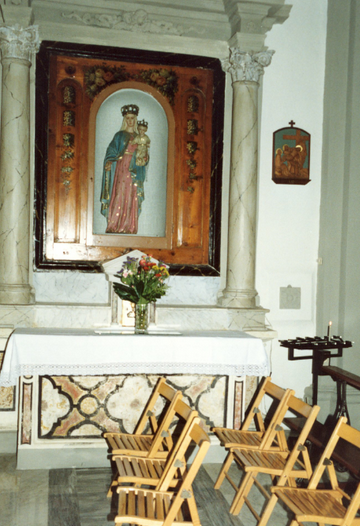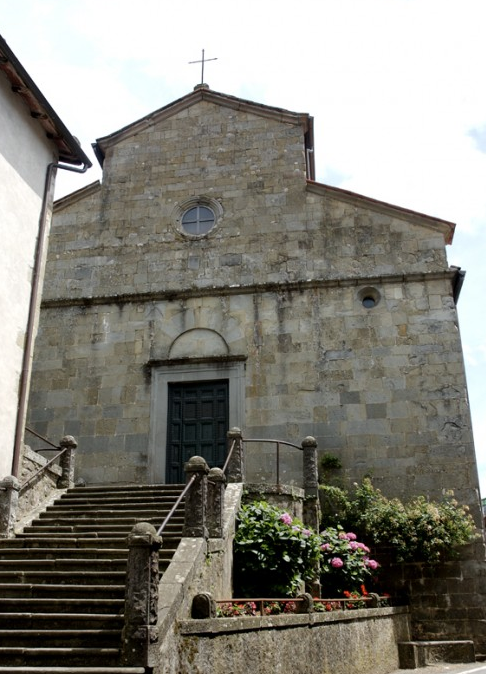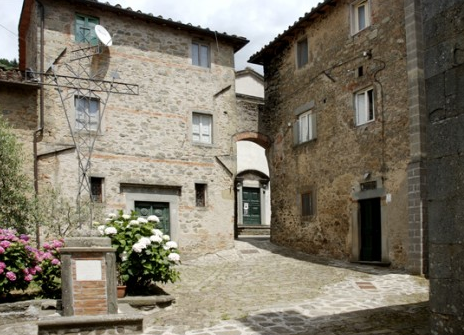QUILIETTI Maria Alfonsa Domenica 1876/Benabio
Maria Alfonsa Domenica Quilietti was born in Castelvecchio Pascoli in Barga in January 1876. She was baptised on 13th January in the Church of St. Nicolo’ in the village.
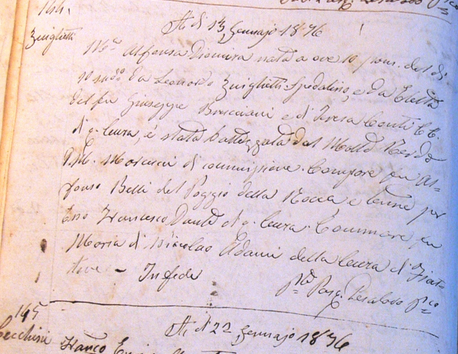
The birth of Maria Alfonso Domenica Quilietti. I love the old way of writing our name Guiglietti. It was written down like this in many documents in the church.
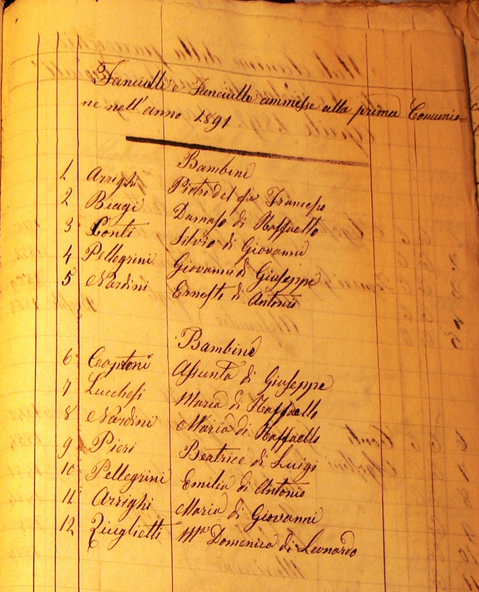
The Church played such a great part in the history of the village by documenting each year the families in a census. On the back page of the documents were the people absent from their homes at the time of the census. You can see above that Maria Domenica of Leonardo was absent at this time. We are assuming that she joined her brother Giuseppe who made several trips back and fro from Rhode Island before he finally emigrated in 1905. But we also know that she returned home before 1903.
1930 USA Census showing Maria’s emigration as the year 1895
There is much mystery surrounding Maria Alfonsa Domenica. From documents we can easily find today we know that Maria had gone back home to Italy from Rhode Island where on 19th February 1903 she gave birth to a daughter who was baptised Eletta Quilietti [Giuglietti]. Her older brother Giuseppe [Joe] was her sponsor and he would have travelled back to Italy when this news was announced. Whether the baby was conceived in the USA or back home in Italy will forever be a mystery. On her return to Rhode Island Maria’s sister Ermenia, who had by now married her first cousin Pietro Dante in Rhode Island, took the baby Eletta and brought her up as their own. The Church would frown on the circumstances of the birth of the baby Ellen as she was unmarried at the time and this adoption would not only help the child but also Maria who could start afresh.
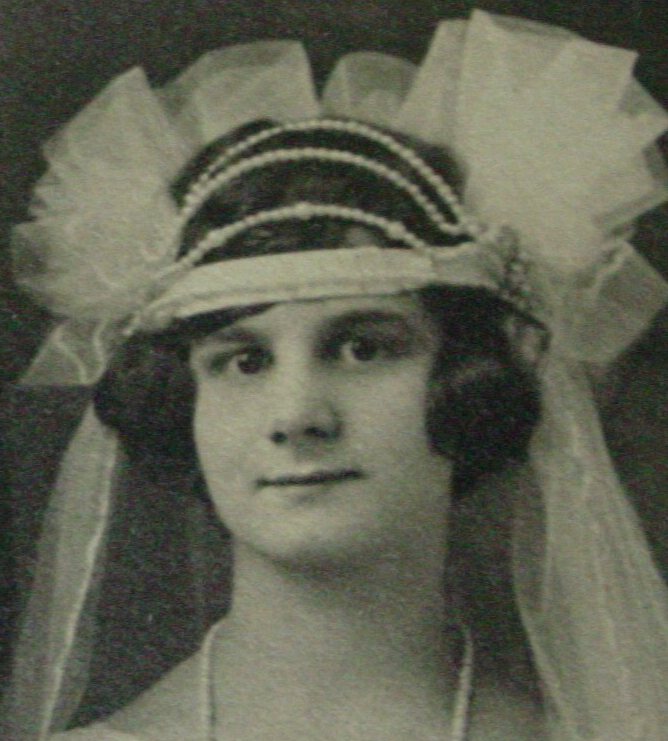
Maria Domenica or Ellen as she was known. She was the daughter or Maria Domenica Quilietti and was born in January 1903 in Castelvecchio. She went on to marry Louis Peter Pelligrini whose family were also from Castelvecchio Pascoli. She died after giving birth to her only son in 1927. Very sad.
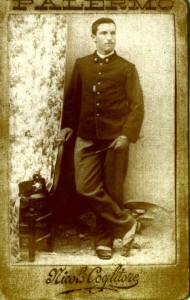
Brother Giuseppe photographed whilst doing his national service in the Italian Army. He was baby’s Ellen’s sponsor at her baptism in Castelvecchio.
This left Maria free to start a new life in 1905 she married Alfredo Benabio, also of Italian descent. Alfred was born in the year 1874 and had also arrived from Italy with his parents in the 1880s. Alfred’s occupation was a mechanic and he ran a garage for many years. The family lived in Sharon Avenue. I believe the Benabio family were also from Tuscany.
Their children
1. ROSE BENABIO 1908. She married into the Squirolloni family in 1930. 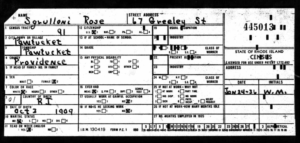
2. JOSEPH BENABIO 1906-1952
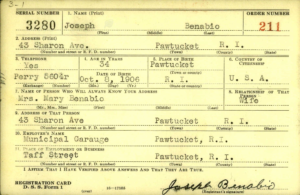
Joseph Benabio. His wife’s name was Mary. He was of short stature, five foot four and a half inches, brown hair and had hazel eyes.
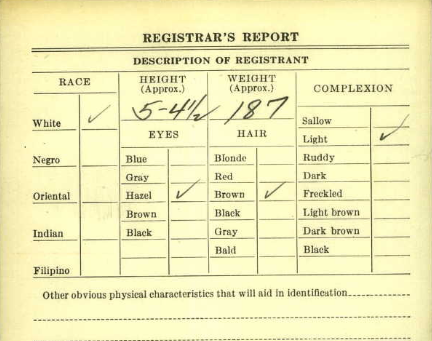
3. CHARLES BENABIO was born on 13 December 1909. He married DORIS or Dolorato Tomassi Grossi in 1929. Doris was born on 11th April 1913 and died on 8th March 2003 Charles died in the June 1972. They had one son also called Charles who was born in 1938. 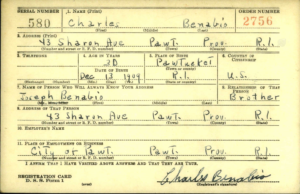
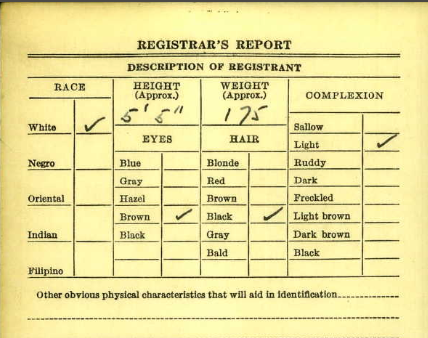
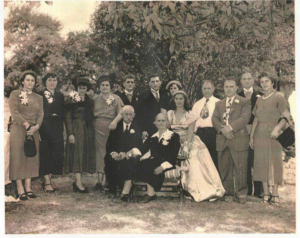
Grossi Tomassi emigrated with his family in 1905. They settled in the North Providence. Their daughter Doris married Joseph Benabio. I believe the surname was originally Tomassi but was changed to Grossi soon after they arrived in Rhode Island. The 1920 USA Census confirms this.


Charles junior married Deborah ms unknown. There may have been two children, Diane and Allen, but this has to be confirmed.
4. AUGUST BENABIO was born in 1911. He died on13 Sept. 1985. He married Margaret McGinn and they had two sons and one daughter, Robert, Richard and Judith who died in 1982. There are other members of this family who are Tracie who was born in 1970 and Richard who was born in 1971.TBC
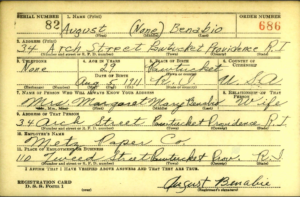
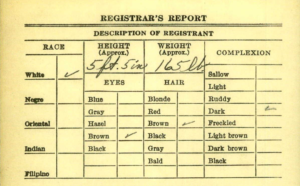
Again he was short in stature with brown hair and eyes and slight of build
5. OLIVE BENABIO
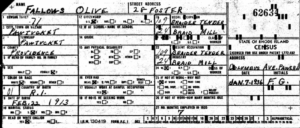 When Olive Benabio was born on 22 February 1913 in Providence, Rhode Island, USA, her father, Alfred, was 39, and her mother, Maria, was 37. She was married in 1930 to unknown Fallows. She died on 17 July 1984 in Pawtucket, Rhode Island, USA, at the age of 71, and was buried there in Mount Saint Mary’s Cemetery where there is a family plot.
When Olive Benabio was born on 22 February 1913 in Providence, Rhode Island, USA, her father, Alfred, was 39, and her mother, Maria, was 37. She was married in 1930 to unknown Fallows. She died on 17 July 1984 in Pawtucket, Rhode Island, USA, at the age of 71, and was buried there in Mount Saint Mary’s Cemetery where there is a family plot.

1938 trade directory
6. AMELIO BENABIO.
. When Amelio Benabio was born on 7 February 1915 in Providence, Rhode Island, USA, his father, Alfred, was 41 and his mother, Maria, was 39. He had one daughter with his wife Mary R Rubinacci in 1942. He died on 19 September 1969 in his hometown at the age of 54, and was buried in Pawtucket, Rhode Island, USA. They had one daughter Carol 1942-2014. 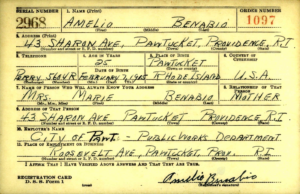
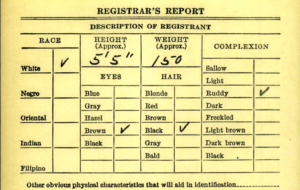
The family have a family plot in Mt. St. Mary’s Cemetery Plot 104 No. 6 where lie the remains of Judith, Olive, Alfred and Margaret. Margaret is the owner of the plot.
Mary Domenica and her husband Alfredo are buried in the old graveyard in Pawtucket, East Providence side of the city.
It would be really great to hear from any of Maria Domenica’s descendants. Maria was the youngest daughter of the Quilietti children and may have passed on vital information regarding the lives of her parents in Italy. Please be in touch if you wish to help us sort out this part of our Quilietti history.
Slater Mill
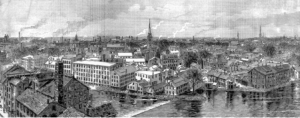
pawtucket
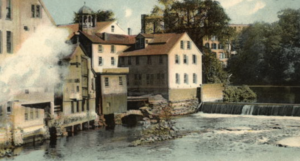 Slater Mill Historic Site, also known as Slater Mill or Old Slater Mill, is located on the Blackstone River in Pawtucket, RI. It is generally cited as the birthplace of the Industrial Revolution in America. It is modelled after a mill in England where Samuel Slater, the mill’s founder, had been an employee. Moses Brown of Providence, Rhode Island, Brown family was one of the major owners of the Mill.
Slater Mill Historic Site, also known as Slater Mill or Old Slater Mill, is located on the Blackstone River in Pawtucket, RI. It is generally cited as the birthplace of the Industrial Revolution in America. It is modelled after a mill in England where Samuel Slater, the mill’s founder, had been an employee. Moses Brown of Providence, Rhode Island, Brown family was one of the major owners of the Mill.
Slater Mill was built in 1793. It served as the first commercially viable cotton-spinning mill in the United States. It was used to convert raw cotton into cloth. Slater brought this new technology from England where he had learned it from Jedediah Strutt. Slater’s design was based on Richard Arkwright’s cotton spinning system which included carding, drawing, and spinning machines.
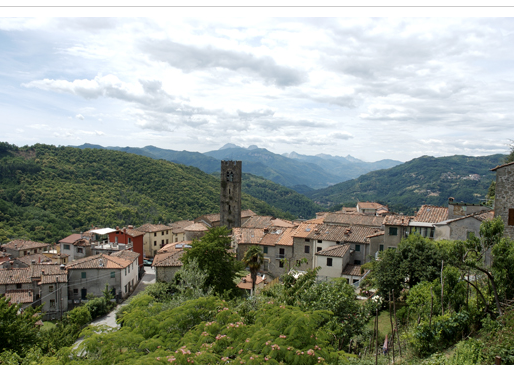
Benabbio is situated 479 meters above sea level and its 5 kilometers from Bagni di Lucca. Bruno Cherubini in his book “I Bagni di Lucca†describes it ‘as a hidden town nearly jealous of itself ’ a well fitting description as it’s not on the hills but on the valleyfloor. The road that brings you to Benabbio goes on to Collodi and the Valleriana. This road was built at the end of the last century and connects Benabbio with Bagni di Lucca. At the beginning of the road to Benabbio theres a place called Dominillo and theres a beautiful view of the town and the surrounding mountains.
Entering Benabbio there’s the square Santa Maria and the parish church Santa Maria Assunta.The church was built in 1338, there is an inscription on the side of the church that looks onto the square. It has three aisles with pillars and ornate capitals, the roof is made with wooden beams.In the apse a triptych of Baldassarre of the late Biagio of Florence commissioned by the men of Benabbio in 1469 the alterpiece has is its centre the Virgin Mary with Child and on the sides two pairs of saints, San Michele e Pietro and San Giovanni Battista e Bartolomeo.
The History
It’s first remembered in a parchment of 983. Originally it was called Menabia then Menabbio, but no-ones certain where it originates from. Benabbio was owned by the Lupar family, the most representative was known as Lupo,remembered as a poet and known for his connection with Castrucciuo Castracani degli Antelminelli. Lupari had sweared to the town of Lucca to look after anf defend the Apennine Mountains and to make sure no-one trespasses from other provinces,but Lupo showed that he was a violent man and never listened to the orders given to him from Lucca.
In 1334 there was an outbreak of war between Lucchesi and Florentines, Lupo was ordered to send all of his men to help Castruccio, but he only sent half of them favouring the occupation of the village of Cerbaiola by the Florentines. But at Altopascio the Lucchesi beat the Florentines then they went to Benabbio to punish Lupo. He was banned from the Republic and fled to Bologna. But a legend tells that he is buried in a tunnel under the castle; where one can enter a well still existing today. The population was famous for its warlike spirit and were known as the best soldiers in the Val di Lima, and even the Province of Lucca used them. In 1798 the population made a revolt against the French forcing them to abandon the village. The French Philosopher Michel de Montaigne visited Benabbio in the summer of 1581 and he describes it as ‘a village big and beautiful’.
In the house that sits on the “Colle di Belvedere in 1837 Luigi Napoleone Bonaparte (Napoleone III) found refuge with the help of duke Carlo Ludovico when he was persued by the King of France Luigi Filippo.
Benabbio was the most populated village in the area, in the year 1566 it had 1600 inhabitants. The antique statutes have been lost but two remain of the 18th century one in the archives of the town council dated 1781 and one in the archives of the state of Lucca.
Famous People
Benabbio was the native birthplace to Father Antonio Cianelli (1753/1827)-author.
Antonio Vivani 1770 (died at Lucca 1830)-poet at Rome and wrote verses for the court of the King of Naples.
Rodolfo Pierotti (1845-1909)-engineer, elected 6 times member of parliament (fought for the unity of Italy).
Francesco Cianelli (1838-1910)-teacher in the seminary of Lucca and Author of numerous inscriptions.
Bagni di Lucca Terme
A site by StudioAF
In the left hand aisle theres a baptism fountain dated 1564 protected by iron railings dated 1601. There’s a lot of value in the church, examples being two wooden side alters of the 17th century on either side of the main alter, two lampshades in wrought iron, also two wooden statues dated 1394 that represent an angel and Padre di Iacopo della Querica by Piero D’Angelo.
Another building worth seeing is the Oratory of S.S Filippo e Giacomo its situated in the square of the Primo Maggio. The ruins of the castle of Benabbio like Lucchio and Casoli are situated at the top of the village. They are the most important castles of the Val di Lima. Lately traces have been found and studied at the University of Pisa.
There is also a theatre called ‘Eden’ opened at the end of the 500’s this shows the passion the population had for acting and music, that in 1876 the Philharmonic society of Benabbio was founded. Excavation and research has been done over the past few years on the antique ruins of the castle by the Department of Paleopathology of the University of Pisa.
